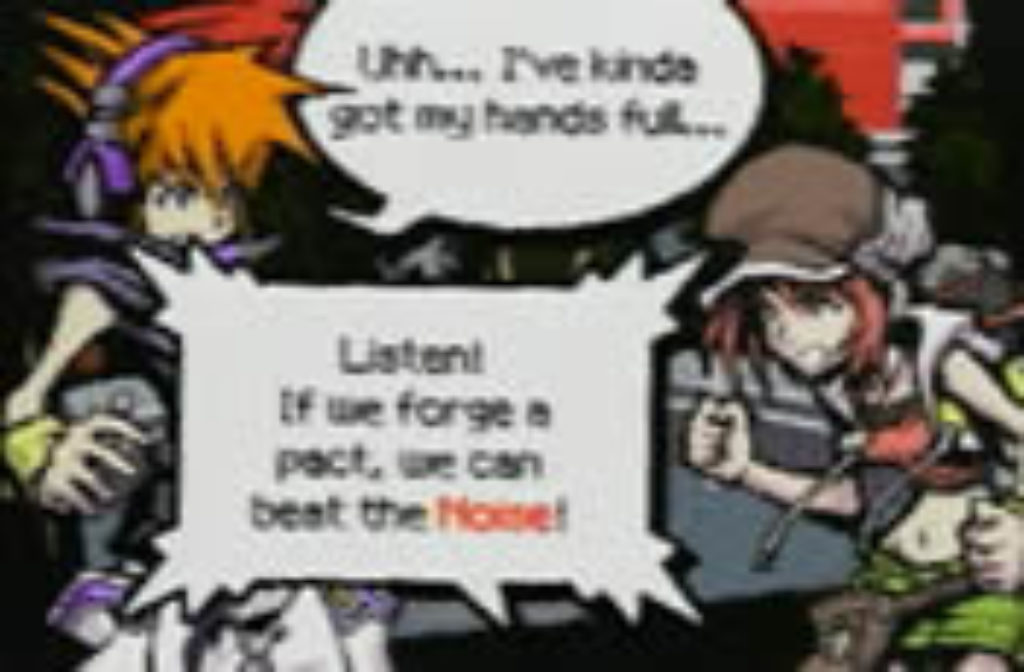
We all have ideas about what happens to us after we die. We think about how we’ll walk through the Pearly Gates, hang with the angels or surround the throne of God. We might imagine heaven as being filled with fluffy clouds, classical architecture, towering mountains—or maybe totally indescribable.
Few of us would’ve imagined that the afterlife would look like downtown Tokyo.
That’s the netherworld to which you’re zapped in The World Ends With You, an anime-style role-playing game created for Nintendo’s portable DS platform. At first the place seems nice enough. You can buy food and hang out with your newly dead friends—all while sharing space, ghostlike, with the clueless living.
But there are problems: Turns out, you’re only mostly dead. And somebody wants to finish the job.
I’m Not Dead Yet!
Players take on the identity of Neku Sakuraba, a sullen, purple-clad misanthrope who likely hoped death would be, well, quieter.
Not that he knows he’s dead, mind you. When we first meet him, he’s lying in the street in Tokyo’s busy Shibuya shopping district, ignored by passersby and baffled by how he got there. He’d like to scratch his head in wonderment, but he can’t because his hands are full: In one, he holds a mysterious pin that allows him to read minds. In the other, there’s a digital timer that’s somehow been implanted in his skin. And it’s counting down.
With help from a budding fashion designer named Shiki, Neku quickly learns that he’s a pawn in a game run by mysterious folks called the Reapers. Turns out, Neku’s goal is to team up with other players and complete a series of tasks or face “erasure”—presumably total obliteration—by the Reapers. (Only later do Neku and Co. realize that they’re already dead and, therefore, partially erased already.)
To make matters worse, players are harassed by supernatural critters called “noise” that can take on the shapes of frogs or bats or other beasties. Neku’s only real weapons against them are his assorted pins (the kind you stick on your lapel) which allow him to zap the creatures with magical fire or lightning or other, er, noise-cancelling effects.
But My Fingers Feel a Bit Numb
These battle sequences are a challenge to master on the DS’ tiny two-inch screen. Players control Neku’s movements, the pins and nearly every aspect of the game using the DS stylus, and it takes a bit of practice to keep Neku from charging into a bunch of evildoers when you really meant to blast them with lightning.
Gamers can control Neku’s teammates, too, who fight on the top screen and are handled via DS button mashing. If gamers think all this interaction is a bit too much, the DS will eventually take over the other character. And for the record, I’m one of those gamers. For me, trying to handle both players was akin to taking the SAT on a roller coaster.
Elsewhere in the “more trouble” category is the fact that Neku swears up a storm (using words such as “h—” “a–” and “d–n”). Another character taunts enemies to “come back when you grow a pair.” And female characters wear clothes that showcase cartoon midriffs and legs. Violence is less of an issue: Battles are bloodless, with tiny enemies vanishing in veritable puffs of smoke when they’re vanquished. Though the anime storyline features some heinous acts of violence—a shootout that results in an onscreen death, for instance—the camera cuts away from the action at these crucial junctures.
The World Is Not Enough
The World Ends With You is not without some merits. It emphasizes friendship, teamwork and, frankly, the importance of being a decent human being. We see this journey through the eyes of Neku, who slowly transforms from a self-absorbed jerk to a more mature fellow. Characters grapple with concepts such as individuality, self-improvement and caring for one another. Indeed, eternity doesn’t so much resemble heaven or hell as it does an afterlife training ground, where characters must learn and improve themselves in order to move on.
But move on to what? Two-inch screen limitations notwithstanding, this game wields a weird afterworld ethos that runs counter to most of what Scripture teaches. Characters who excel at aforementioned self-improvement are rewarded with a return trip to the land of the living—no great trophy considering Shibuya looks pretty much the same whether you’re living or dead. Folks dress the same, talk the same and act the same. Thus the distinction between life and death, this world and the next, is blurred.
Then there’s the fact that players who take part in the Reapers’ deadly game must stake a treasured possession—including the lives of those they most care about—in order to “play.” And in the process, they make their way through a netherworld populated by tons of beings that aren’t exactly human, but not precisely divine. Who are the Reapers, for instance? We’re never told, though we learn winning players can become a Reaper if they so desire.
The World Ends With You bore an original Japanese title that translates as This Is a Wonderful World. Is the irony intentional? I don’t know. But most spiritually discerning gamers will beg to differ.

Paul Asay has been part of the Plugged In staff since 2007, watching and reviewing roughly 15 quintillion movies and television shows. He’s written for a number of other publications, too, including Time, The Washington Post and Christianity Today. The author of several books, Paul loves to find spirituality in unexpected places, including popular entertainment, and he loves all things superhero. His vices include James Bond films, Mountain Dew and terrible B-grade movies. He’s married, has two children and a neurotic dog, runs marathons on occasion and hopes to someday own his own tuxedo. Feel free to follow him on Twitter @AsayPaul.